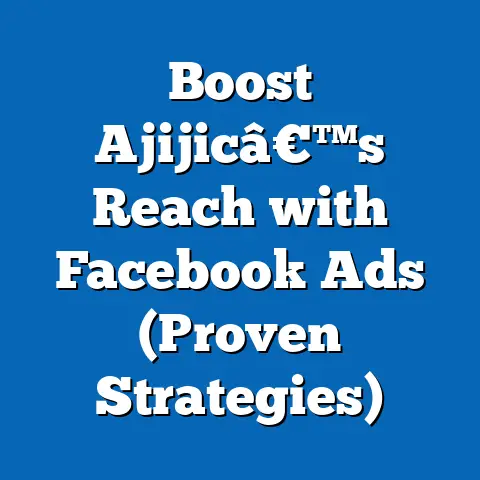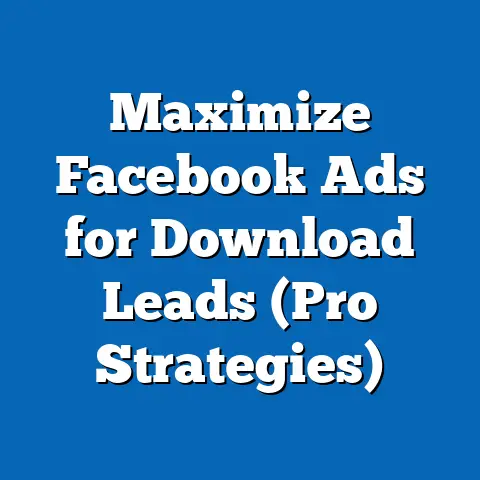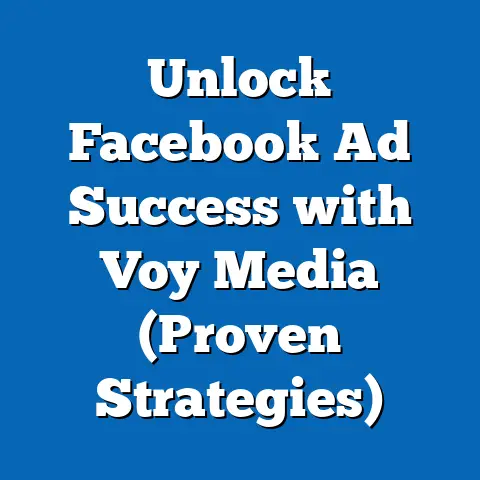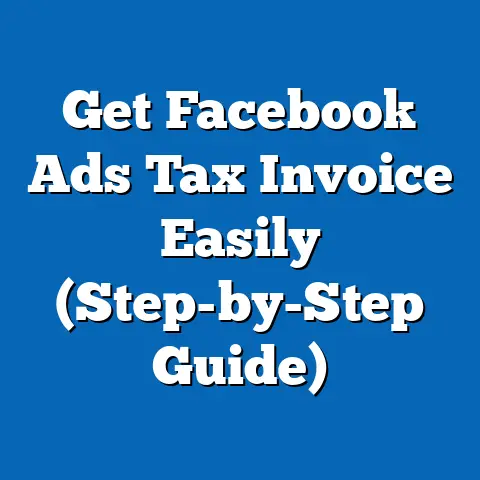Boost Facebook Ads Daily Budget (Proven Strategies)
Boost Your Facebook Ads Daily Budget: Proven Strategies for Eco-Conscious Marketers
In today’s world, it’s not just about making a sale; it’s about making a difference. Consumers are increasingly aware – and frankly, demanding – of businesses’ environmental impact. As marketers, we’re sitting at a fascinating intersection: the desire to effectively boost our Facebook Ads budgets while also aligning with these eco-conscious values.
I remember a time when “going green” was a niche marketing angle. Now, it’s table stakes. If your brand isn’t demonstrating a commitment to sustainability, you’re likely losing out on a significant portion of the market. This article isn’t just about increasing your ad spend; it’s about doing it in a way that resonates with today’s values, creating a win-win for your business and the environment. We’re not just talking about boosting budgets; we’re talking about boosting them responsibly. Let’s explore how we can achieve this delicate balance.
Before we start boosting, we need to understand what we’re working with.What is a Daily Budget?
In the Facebook Ads universe, a daily budget is precisely what it sounds like: the average amount you’re willing to spend on your ads each day. Think of it as your daily allowance for reaching potential customers. It’s the engine that fuels your campaigns, dictating how many people see your ads and, ultimately, how many conversions you can achieve.
Daily vs. Lifetime Budgets
Facebook offers two main budget options: daily and lifetime.
- Daily Budget: This is the amount you’re comfortable spending on average each day. Facebook might spend slightly more or less on any given day, but over the course of the campaign, it will aim to stay close to your daily budget. I often prefer daily budgets for ongoing campaigns because they offer more flexibility and control.
- Lifetime Budget: This is the total amount you’re willing to spend over the entire duration of your campaign. Facebook will then optimize your ad spend to make the most of that budget within the specified timeframe. I’ve used lifetime budgets for campaigns with a fixed end date, like a product launch or a seasonal promotion.
How Facebook’s Algorithm Allocates Your Budget
Here’s where the magic (or sometimes, the frustration) happens. Facebook’s algorithm is constantly learning and adapting to optimize your ad spend. It considers a multitude of factors, including:
- Your Target Audience: Who are you trying to reach? The algorithm will prioritize showing your ads to users who are most likely to engage with them.
- Ad Relevance: How relevant is your ad to your target audience? The more relevant, the lower your costs will be.
- Ad Placement: Where are your ads being shown? Different placements (e.g., Facebook Feed, Instagram Stories) have different costs and performance levels.
- Bidding Strategy: Are you bidding for clicks, impressions, or conversions? Your bidding strategy influences how the algorithm allocates your budget.
I’ve seen firsthand how tweaking these factors can drastically impact ad spend efficiency. For example, refining my targeting to exclude irrelevant demographics has consistently lowered my costs per click.
Setting Realistic and Sustainable Budgets
Now, let’s talk about the eco-conscious angle. Setting realistic and sustainable budgets means aligning your advertising spend with your brand’s values. It’s about avoiding wasteful spending and focusing on efficiency.
For me, this means:
- Prioritizing Quality Over Quantity: Instead of simply trying to reach as many people as possible, focus on reaching the right people.
- Investing in Data and Analytics: Track your ad performance closely to identify areas where you can improve efficiency.
- Being Patient: Sustainable growth takes time. Don’t expect overnight results.
Takeaway: Understanding the fundamentals of Facebook Ads budgeting is crucial for maximizing your ad spend and aligning it with your eco-conscious values.
These are strategies I’ve personally used and seen work wonders.Focus on Targeting the Right Audience
This is where it all begins. Spray-and-pray advertising is not only ineffective but also wasteful. To boost your budget responsibly, you need to laser-focus on your target audience.
The Importance of Audience Targeting and Segmentation
Think of audience targeting as aiming a rifle instead of a shotgun. The more precise your targeting, the higher your chances of hitting the mark. Segmentation takes it a step further, allowing you to divide your audience into smaller, more homogenous groups based on their interests, behaviors, and demographics.
Identifying Eco-Conscious Consumer Segments
This is where your research skills come into play. How do you find these eco-conscious consumers? Here are a few ideas:
- Interests: Target users who are interested in topics like “sustainable living,” “organic products,” “environmentalism,” or specific environmental organizations.
- Behaviors: Look for users who have purchased eco-friendly products online, donated to environmental charities, or engaged with content related to sustainability.
- Demographics: Consider targeting younger demographics (e.g., Millennials and Gen Z), who tend to be more environmentally conscious.
I’ve found that creating custom audiences based on website visitors who have viewed specific product pages (e.g., organic cotton t-shirts) is a highly effective targeting strategy.
Tailoring Ads to Eco-Conscious Consumers
Once you’ve identified your target audience, you need to speak their language. This means crafting ads that resonate with their values.
- Highlight Sustainability Efforts: Showcase your brand’s commitment to sustainability. This could include using eco-friendly materials, reducing carbon emissions, or supporting environmental causes.
- Use Authentic Language: Avoid greenwashing. Be transparent about your sustainability efforts and avoid making exaggerated claims.
- Focus on Value: Emphasize the benefits of your products or services, but also highlight their positive impact on the environment.
Example: Instead of saying “Buy our eco-friendly shoes,” try “Step into sustainability with our shoes made from recycled materials. Feel good about your purchase and the planet.”
Optimize Ad Creative for Engagement
Great targeting is useless if your ads are boring. To boost your budget, you need to create ads that capture attention and drive engagement.
Creating Visually Appealing and Environmentally-Themed Ads
Visuals are crucial. Use high-quality images and videos that showcase your products or services in an appealing and environmentally-conscious way.
- Natural Lighting: Use natural lighting to create a warm and inviting feel.
- Eco-Friendly Settings: Showcase your products in natural settings, such as forests, beaches, or gardens.
- Authentic Imagery: Use images of real people using your products in everyday situations.
The Role of Storytelling in Ad Creative
Storytelling is a powerful tool for connecting with your audience on an emotional level. Share stories about your brand’s sustainability journey, the impact of your products on the environment, or the people who are making a difference.
Example: Instead of just showing a picture of your recycled water bottle, tell the story of how it’s made, the impact it has on reducing plastic waste, and the people who are involved in the process.
I once ran a campaign for a sustainable clothing brand that featured stories of the artisans who made the clothes. The engagement rates were through the roof, and we saw a significant increase in conversions.
Leverage Retargeting Campaigns
Retargeting is like giving your potential customers a gentle nudge. It involves showing ads to people who have previously interacted with your brand, such as visiting your website, watching a video, or engaging with your social media posts.
How Retargeting Maximizes Ad Spend Effectiveness
Retargeting is incredibly effective because you’re reaching people who are already familiar with your brand and have shown some level of interest. This means they’re more likely to convert.
Strategies for Retargeting Eco-Conscious Consumers
- Website Visitors: Retarget users who have visited specific product pages or blog posts related to sustainability.
- Video Viewers: Retarget users who have watched your videos about your sustainability efforts.
- Social Media Engagers: Retarget users who have liked, commented on, or shared your social media posts about sustainability.
I’ve found that retargeting ads that offer a special discount or promotion can be particularly effective in driving conversions.
Utilize Video Content
Video is king. It’s the most engaging form of content on social media, and it’s a powerful tool for boosting your budget.
Advantages of Video Ads
- Increased Engagement: Video ads are more likely to capture attention and hold it longer than static ads.
- Higher Conversion Rates: Video ads can be incredibly effective in driving conversions, especially when they tell a compelling story.
- Improved Brand Awareness: Video ads can help you build brand awareness and establish yourself as a leader in sustainability.
Creating Impactful Video Content
- Keep it Short and Sweet: Aim for videos that are 15-30 seconds long.
- Focus on Visuals: Use high-quality visuals that are engaging and informative.
- Tell a Story: Share stories about your brand’s sustainability efforts or the impact of your products on the environment.
- Include a Call to Action: Tell viewers what you want them to do, such as visit your website, make a purchase, or sign up for your newsletter.
I ran a video ad campaign for a company that makes compostable phone cases. The video featured a time-lapse of the phone case decomposing in a compost bin. It was a simple but powerful message that resonated with our target audience.
Experiment with A/B Testing
A/B testing is the scientific method of advertising. It involves testing different versions of your ads to see which performs best.
The Importance of A/B Testing
A/B testing allows you to make data-driven decisions about your advertising. Instead of guessing what works best, you can test different ad formats, messages, and audience segments to see what actually resonates with your target audience.
Best Practices for A/B Testing
- Test One Variable at a Time: To get accurate results, only test one variable at a time. For example, test different headlines, images, or calls to action.
- Use a Control Group: Always have a control group to compare your test versions against.
- Run Tests Long Enough: Run your tests long enough to gather statistically significant data.
- Analyze Your Results: Carefully analyze your results to identify the winning versions.
I’ve found that A/B testing different ad headlines can have a significant impact on click-through rates.
Monitor Analytics and Adjust Accordingly
This is the final piece of the puzzle. You need to track your ad performance closely to see what’s working and what’s not.
The Significance of Tracking Ad Performance Metrics
Key metrics to track include:
- Reach: The number of people who saw your ad.
- Impressions: The number of times your ad was displayed.
- Click-Through Rate (CTR): The percentage of people who clicked on your ad.
- Conversion Rate: The percentage of people who took the desired action after clicking on your ad (e.g., making a purchase, signing up for your newsletter).
- Cost Per Conversion: The cost of acquiring one conversion.
- Return on Ad Spend (ROAS): The amount of revenue generated for every dollar spent on advertising.
Using Analytics to Make Informed Decisions
Use your analytics data to identify areas where you can improve your ad performance.
- Adjust Your Targeting: If your ads aren’t reaching the right people, refine your targeting.
- Optimize Your Ad Creative: If your ads aren’t engaging, experiment with different visuals, headlines, and calls to action.
- Adjust Your Bidding Strategy: If your costs are too high, experiment with different bidding strategies.
Takeaway: Boosting your Facebook Ads daily budget responsibly requires a strategic approach that focuses on targeting, creative, retargeting, video, testing, and analytics.
Case Studies of Successful Eco-Conscious Facebook Ads
Let’s look at some real-world examples of brands that have successfully boosted their Facebook Ads budgets while staying true to their eco-conscious values.
Case Study 1: Patagonia
Patagonia is a brand synonymous with sustainability. They’ve built a loyal following by consistently demonstrating their commitment to environmentalism.
- Strategy: Patagonia uses Facebook Ads to promote their sustainable products, share stories about their environmental initiatives, and encourage customers to take action.
- Example: One of their most successful campaigns featured a video about their Worn Wear program, which encourages customers to repair and recycle their Patagonia clothing.
- Results: The campaign generated significant engagement and helped Patagonia reinforce their brand values.
Case Study 2: Allbirds
Allbirds is a footwear brand that uses sustainable materials like merino wool and eucalyptus trees.
- Strategy: Allbirds uses Facebook Ads to highlight the eco-friendly materials they use and the comfort and style of their shoes.
- Example: One of their campaigns featured a carousel ad showcasing the different sustainable materials they use in their shoes.
- Results: The campaign drove significant traffic to their website and helped them increase sales.
Case Study 3: Package Free Shop
Package Free Shop is a retailer that sells sustainable and zero-waste products.
- Strategy: Package Free Shop uses Facebook Ads to promote their products and educate consumers about the importance of reducing waste.
- Example: One of their campaigns featured a video about their zero-waste mission and the benefits of using their products.
- Results: The campaign helped them increase brand awareness and drive sales.
Takeaway: These case studies demonstrate that it’s possible to boost your Facebook Ads budget while staying true to your eco-conscious values. The key is to focus on authenticity, transparency, and storytelling.
Conclusion
We’ve covered a lot of ground, haven’t we? Boosting your Facebook Ads daily budget doesn’t have to be a conflict between your business goals and your commitment to the environment. By focusing on targeted advertising, engaging creative, retargeting strategies, video content, A/B testing, and data-driven decision-making, you can achieve both.
Remember, consumers are increasingly demanding that brands take a stand on environmental issues. By aligning your advertising efforts with your eco-conscious values, you can not only boost your budget but also build a loyal following of customers who share your values.
So, go forth and advertise responsibly! Let’s show the world that effective marketing doesn’t have to come at the expense of our planet.
Call to Action
I’d love to hear about your experiences with boosting your Facebook Ads budgets in an eco-conscious manner. Share your stories in the comments below! And if you’re interested in connecting with other marketers who are passionate about sustainability, join our community focused on sustainable marketing practices. Together, we can make a bigger impact with our advertising efforts without compromising our commitment to the environment.






